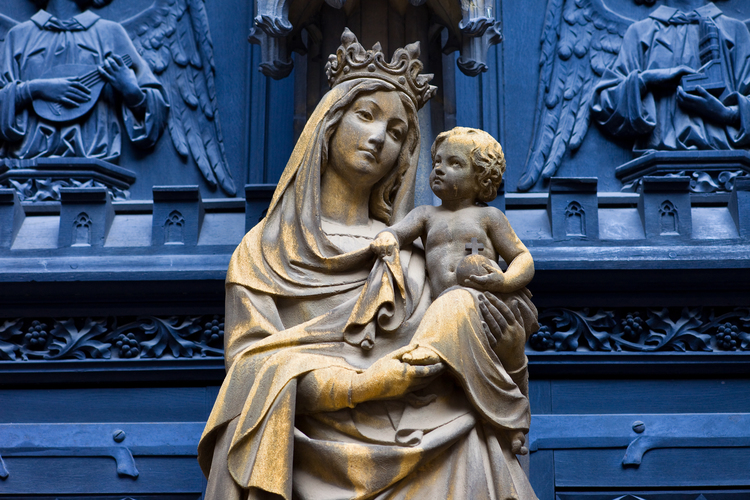
Best Comet of 2025?
C/2024 G3 (ATLAS) has already become very faintly visible to the naked eye for observers in the Southern Hemisphere.
The Christian feast day of the Assumption of Mary celebrates the belief that God assumed the Virgin Mary into Heaven following her death.

The feast day of the Assumption of Mary commemorates the Virgin Mary's assumption into heaven.
©iStockphoto.com/benedek
Assumption Day is celebrated on or around August 15 in many countries, particularly in parts of Europe and South America. It is also called the Assumption of the Blessed Virgin Mary, the Dormition of the Most Holy Mother of God (in the eastern countries), or the Feast of the Assumption.
Colorful processions through the streets and firework displays mark the celebration of the Feast of the Assumption in Italy, as they do in Italian-American communities throughout the United States. In Sicily and rural areas outside Rome, a bowing procession is the day’s main event. A statue of the Virgin Mary is carried through the town to a ceremonial arch of flowers, where a group of people holding a statue of Christ awaits her arrival. Both statues are inclined toward each other three times, and then the Christ figure precedes the figure of Mary back to the parish church for a special benediction.
In Sao Paulo and other parts of southern Brazil, the feast is called Nosa Senhora dos Navegantes, or “Our Lady of the Navigators”. Pageants are held on decorated canoes, each carrying a captain, a purser, three musicians, and two rowers. They travel to small villages to entertain and feast. Towns may have small church processions with musicians whose costumes and demeanors depict the “Three Wise Men” who are mentioned in the Bible.
In previous years some Italian plazas were flooded. Citizens would ride through the temporary “lakes” in carriages and it was common for people to carry bowls of rose-scented water, which they sprinkled on themselves – possibly a carryover from a pagan ritual in which the gods were petitioned to provide adequate rainfall for the crops, or as a tribute to the pagan goddess Isis of the Sea. Assumption Day is also an important holiday in France where the Virgin Mary has been the patron saint since 1638.
Assumption Day is a public holiday in countries such as Austria, Belgium, Chile, Croatia, France, parts of Germany, Guatemala, Greece, Italy, Poland, Portugal, Slovenia, Spain and Switzerland (the holiday may be regional or limited to certain groups in Switzerland). However, Assumption Day is not a public holiday in countries such as Australia, Canada, the United Kingdom, and the United States.
Assumption Day commemorates the belief that when Mary, the mother of Jesus Christ, died, her body was not subjected to the usual process of physical decay but was “assumed” into heaven and reunited there with her soul. This holiday, which has been celebrated since the fourth century CE, is a Christianization of an earlier harvest festival and, in many parts of Europe, is known as the Feast of Our Lady of the Harvest.
For centuries celebrations were held in the honor of the goddess Isis of the Sea, who was born on this day according to mythology. With the coming of Christianity church leaders decided that the easiest way to handle this pagan ritual was to simply change it into a Christian holiday, hence the introduction of Assumption Day came forth.
Like the Immaculate Conception, the Assumption was not always an official dogma of the Roman Catholic Church – not until Pope Pius XII ruled it so in 1950. It is, however, a pious belief held by some Orthodox Christians and some Anglicans. It is regarded as the principal feast day of the Virgin Mother.
Remnants of the ancient celebration include night time bonfires and public illuminations, both probably symbolic of the Sun, in Italy. The idea of prosperity is also evident in the throwing of coins from windows down to the street in some cultures. Symbolic images of the Virgin Mary and her assumption into heaven have been associated with the day. Blue is the color most often associated with the Virgin Mary. It symbolizes truth and clarity, and it is the color of the sky, which symbolizes heaven. The lily, which is a symbol of purity, chastity, and simplicity, is also associated with the Virgin Mary.

C/2024 G3 (ATLAS) has already become very faintly visible to the naked eye for observers in the Southern Hemisphere.

How does the 12-hour clock system work? Is midnight 12 am or 12 pm?

Why do many countries set the clocks back and forth an hour twice a year?

Why are there 12 months? How long are they, and what do the month names mean?